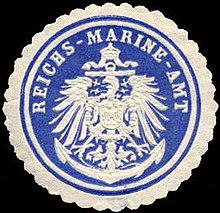Reichsmarineamt

The Reichsmarineamt was a Reich authority in the German Empire that emerged from the Imperial Admiralty in 1889 . It was headed by a state secretary . As an immediate authority, it was directly subordinate to the emperor, so it was not subject to any responsibility towards parliament with the exception of the budget approval . The heads subordinate to the State Secretary were lecturing councils with the rank of councils I. – III. Class. Their titles were: Real Secret Admiralty Council, Secret Admiralty Council, and Real Admiralty Council. Personnel matters were handled by the head of theNaval Cabinet done.
The Reichsmarineamt had the function of a Ministry for the Imperial Navy . According to the imperial constitution of 1871 , the federal states were responsible for the land forces and the empire for the navy. So there was a Prussian , Bavarian , Saxon and Wuerttemberg army and next to it an Imperial Navy. Only these and the Schutztruppe were Reich authorities.
The tasks of the Reichsmarineamt were mainly of an administrative nature. The imperial shipyards in Danzig , Kiel and Wilhelmshaven , the naval training institutes and the German sea observatory in Hamburg were subordinate to it. The marine ordinance sheet has been used for publications since 1870 . In 1897 the intelligence department of the Reichsmarineamte (Dept. N) was established. It served the purpose of gathering information and was intended to arouse interest in the German public in military and civil maritime affairs.
The operational management of the Imperial Navy, which was under the direct supreme command of the Kaiser, was the responsibility of the High Command , later the Chief of the High Seas Fleet , the station commands and other independent units such as the East Asia Squadron .
In 1898, the Reichsmarineamt also took over the administration of the Kiautschou lease port - and not the otherwise responsible Reichskolonialamt . At the head of the protected area, the governor was a naval officer who was directly responsible to the State Secretary. During the First World War , the Reichsmarineamt published the list of casualties of the Imperial Navy.
After the end of the war and the Imperial Navy, the duties of the Reichsmarineamt were temporarily taken over again from March 26, 1919 by the Admiralty , and from September 15, 1920 by the naval management .
The Reichsmarineamt received an office building in Berlin at the more elegant address Leipziger Platz 13 opposite the manor house . It was on the northeast sloping side of the square. As Vossstrasse 24 it had a back entrance, which was also the address for the naval high command .
From 1911 a large new building (" Bendlerblock ") was built one kilometer west in the Königin-Augusta-Straße (from 1933: Tirpitzufer, today Reichpietschufer ) on the northern bank of the Landwehr Canal , into the Reichsmarineamt and the other offices of the Navy in Berlin from 1914 pulled. In 1926/1927 the building on Leipziger Platz was demolished in order to expand the Wertheim department store .
The doors of the Reichsmarineamt are kept in the Military History Museum of the Bundeswehr . The reliefs of the representative doors show maritime motifs such as signal flags, telescopes, anchors and divers, communications technology and ordnance.
| State Secretaries of the Reichsmarinamt | |||
| Surname | Taking office | Term expires | |
|---|---|---|---|
| Karl Eduard Heusner | 1889 | 1890 | |
| Friedrich von Hollmann | 1890 | 1897 | |
| Alfred von Tirpitz | 1897 | 1916 | |
| Eduard von Capelle | 1916 | 1918 | |
| Paul Behncke | 1918 | 1918 | |
| Ernst Karl August Klemens Ritter von Mann | 1918 | 1919 | |
| Maximilian Rogge | January 9, 1919 | February 13, 1919 | |
literature
- Walther Hubatsch : The admiralty staff and the highest naval authorities in Germany, 1848-1945. Bernard & Graefe, Frankfurt am Main 1958.
Web links
- reichskanzlei-3d.de 3D animation of the building in Vossstrasse
Individual evidence
- ↑ a b Großkopff, von Brandenstein: Handbook for the administrative service . 5th edition. Heymanns, Berlin 1912, 1st volume, p. 117 f.
- ↑ FliegerRevue , X, No. 44, p. 14
- ↑ Entrusted with the conduct of business. - Gerhard Engel, Bärbel Holtz, Ingo Materna: Gross-Berliner workers 'and soldiers' councils in the revolution of 1818/1919: documents of the plenary assemblies and the executive council: from the outbreak of the revolution to the 1st Reichsrätekongress . Berlin 1993, p. 114, fn. 11
Coordinates: 52 ° 30 ′ 25 " N , 13 ° 21 ′ 41" E


